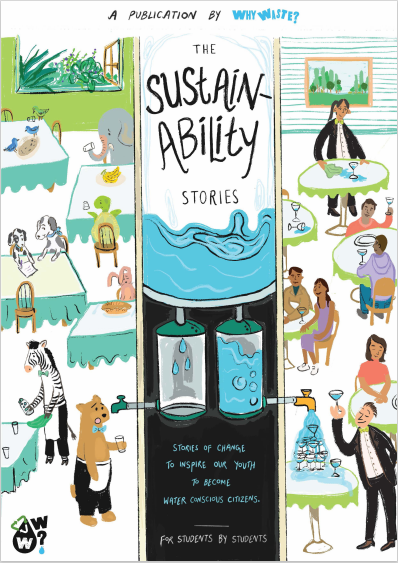On translating children's books: A Google Serve volunteer's story
Posted by Remya Padmadas on January 06, 2020Karthigeyan Sivaraj is a Google Serve campaign volunteer who has worked with StoryWeaver to help translate several storybooks into Tamil, including I Can Climb! and My Best Friend.
In this Q&A, Karthigeyan shares his experience about translating on StoryWeaver, his insight into the translation process, and his love for children's literature.

Q: Do tell us a little bit about yourself, your interests, your work
I'm a Googler by profession and by practice, and I'm proud of that! At work, being a Googler means respecting my colleagues and welcoming their opinions and ideas, howsoever different they may be to my own, and keeping things necessarily simple to my stakeholders, and I attempt to do the same outside the walls of my office as well. Having learned how to analyze data on the job, I brand myself as a data story-teller - i.e., processing data and presenting meaningful information in a way that pushes the audience to take the desired action. The interesting aspect of my job is that it allows me to improve the existing processes through imaginative ways and take ownership of some of the workflows in my organisation, thereby ensuring candidates joining Google have a lasting positive impression about their onboarding experience.
Q: Do you remember the first time you heard about StoryWeaver? What are your thoughts about the platform?
Of course, it's quite vivid in my memory the first time I heard about StoryWeaver. The concept of weaving children's stories is quite dear to my heart, and it's really gladdening to see the team working behind crafting stories as well as making them available in multiple different languages for the young audience to read and relish. I personally nurtured a similar idea a few years ago when I was an avid blogger but didn't have the imaginative power nor the enterprising capabilities to venture into this domain - I was really happy to find the StoryWeaver team doing some marvellous work in this field. Kudos to all!
Q: What was your experience of the GServe campaign, and translating books with fellow Google volunteers?
It's always a very humbling experience to take part in any GServe campaign, no matter what the cause that's being championed. The StoryWeaver campaign was very well thought through in many ways - for one, it didn't require us to sacrifice the luxury of our desks and we could contribute while at work or on the move. It was also so much fluid socializing with fellow Googlers who were taking up similar translation work. Overall, it was a rewarding experience to be able to contribute our might in little ways possible to make a huge change!
Q: We are so glad that you came on board as a commissioned translator even after the GServe campaign! What prompted you to stay in touch?
As I had mentioned previously, contributing to children's literature was always dear to me, and when I got to know about StoryWeaver's mission and their robust infrastructure, I felt relieved knowing that I didn't have to worry too much about the modus operandi, but rather focus on the work itself. With a major piece of work shouldered by the StoryWeaver team, I wanted to work with the team even after the GServe campaign, so that I could do what I like to do - writing, crafting and translating.
Q: What was your experience of being a commissioned translator? Did you pick up any new tips and techniques?
A lot I must say! One very important technique I adopted pretty early on was that I realized that translating the original work into the language of my preference required knowing the cultural nuances deeply. For instance, while translating a story from English targeting the Hindi speaking audience and translating it into Tamil would mean we will have to take into account the various cultural aspects such as the equivalent idioms used in the region. Internalizing all these cultural & regional nuances in the local language while translating is imperative if the audience has to relate to the stories. Else, they wouldn't 'stick'!
Q: How tricky is it to translate stories to Tamil? Are there any phrases that you particularly spent time on because they were difficult to translate?
Tamil, for all its richness, is a very unique language in that there are several different dialects in use across the Tamil diaspora. It becomes even trickier when you realize that the written form of the language is very different to the conversational style, and even the conversational style assumes a different shade when it comes to young audiences. Stories will have to be narrated to children in a style that's neither too formal nor too conversational and we should be ready to use a few English words that are in daily use, so they can relate to them. Also, unfortunately, tools such as Google Translate provide very literal translations of phrases which is sometimes very challenging even to the mature audience, hence you have to take a judgement call based on your own intuition and observation. I bet this is true for many Indic languages!
Q: What has been your favourite book to translate on StoryWeaver?
That's a tough one! Each of the books takes you down memory lane and makes you relive your childhood :) Be it Rani's First Day at School or the restless lad who couldn't wait to open this birthday gifts the next day or the fearless little girl - each provides a glimpse of your own childhood. For the sake of picking one, I would go for I Can Climb! which is packed with a lot of positive self-talk for young kids who are taking baby steps as they encounter different activities for the very first time in their lives.
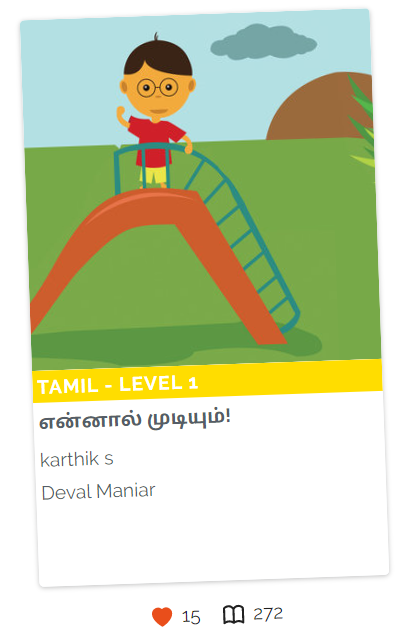
Q: What are some of your favourite books from childhood? Is there any memorable reading moment that you would like to share?
I relished reading across different genres in both English and Tamil. In Tamil literature, especially that was taught to us in school, all messages were delivered in a cryptic fashion replete with metaphors and similes. That allowed for deep learning, situational paraphrasing and lateral thinking. For that very same reason, I preferred the works of John Milton, Rudyard Kipling & John Keats in English and innumerable poets in Tamil.
As a kid, I was an avid read of Tinkle Kids' magazines, and I used to eagerly await the next monthly edition. I am really glad to see that same level of curiosity now possessed by my niece. It seems the magazine hasn't lost its attractiveness to date!
Q: The translations you have contributed to our platform have been read over 1800 times - thank you! How has your StoryWeaver journey been? What is one big takeaway from this experience?
The biggest takeaway for me has been that we shouldn't shy away from walking in the little shoes of our young audience to truly understand what holds their curiosity and interest. Many a time, we - adult learners - tend to wear our own caps, and view children's literature in a rather lop-sided manner. However, we should be ready to speak the language of the kids (sometimes even practise prattling), simplify the language (without over-simplifying at the cost of losing the essence) to suit them and be more imaginative (what helped me to feel the pulse of the audience was to subject my work to, what I like to call, the 'niece'-test - i.e., talking to my nieces and having them vet some of my initial works)
Do leave your thoughts in the comments section below. You can also reach out to us through our social media channels: Facebook, Twitter and Instagram.
Be the first to comment.A conversation with Garvita Gulhati, Founder & CEO of 'Why Waste?', discussing their Sustainability Stories book series on StoryWeaver
Posted by Pallavi Kamath on December 03, 2020New books on StoryWeaver!
Presenting ‘The Sustainability Stories’ - a collection of stories conceptualised and published by not-for-profit organisation Why Waste?, written by young adults, for young adults in the making. Explore concepts of water conservation through the lives of Zelly the Zebra, Hali the Elephant, Lonely Cloud, and many more. Learn about the water cycle, Why Waste’s famous #GlassHalfFull concept, the mindful usage of water, and most of all, inspire young minds to be the change that they wish to see in the world!
Learn about Why Waste's work and the inspiration that led to the creation of the Sustainability Stories, in this conversation with their Founder & CEO, Garvita Gulhati:
Tell us about Why Waste?, and your work in the area of water conservation.
Garvita: Why Waste? is a not-for-profit organisation, with a team of like-minded youth who are taking water positivity to the world stage, by means of innovative education and ideas that bring about a systemic change. Why Waste? was founded in 2015 with the aim of changing the mindsets of people towards natural resources, specifically water and envisioning building a world of water conscious citizens. Why Waste?’s #GlassHalfFull movement to conserve water in restaurants went viral in 2019 and continues to have a massive positive impact on the industry with the support of NRAI. Why Waste? has been recognised as an ‘Ashoka Youth Venture’ in 2016. In 2020, the team became India’s largest youth-led movement by an organisation working towards water conservation and have been named as “Water Heros” by Republic TV in a collaborative initiative with the Government of India (Ministry of Jal Shakti).
Some of our initiatives include:
The Urban Water Challenge which is an annual child development programme that helps rural children to come up with innovative ideas towards sustainability.
Prerana- Story-telling sessions at NGOs and rural schools where the team talk about the sustainable stories created by Why Waste?.
Annual World Water Day Event where the team of Why Waste? celebrate water and demonstrate the importance of water conservation with fun-filled activities.
Hopeschooling, a recent initiative by Why Waste? in order to spread hope, motivation and raise awareness about pressing issues in the current world. This initiative was started during the peak of Covid-19, to encourage people to be better.
What inspired you to conceptualise the Sustainability Stories book series?
Garvita: I remember celebrating more birthdays at orphanages than at parties - Always having to finish all the food that I took on my plate. Through my early life, I learnt to empathize and enforce positive habits. The social sensitivity in me comes from practices like this, inculcated through my formative years. Understanding how crucial those experiences were, I conceptualised this series.Through the stories in this series, we hope that children inculcate these same values from a very young age, in a way best known to them - through fables and fairytales.
We are at a point where the world is now restructuring and reconsidering what the youth learn. The team at Why Waste? decided to take a step towards this by introducing stories that inspire our generation to not just love our planet, but also work towards a more holistic and sustainable world. Thereby, shaping our futures.
We would love to know more about the making of these books, especially the "For students, by students" aspect.
Garvita: Being a 100% youth-led movement, Why Waste? has always had wonderful young people volunteer and our goal is to always ensure that they are using their best talents to support our efforts and channel their changemaking energy. When the book was conceptualised, it was almost an obvious choice to have young writers, editors and illustrators create the entire book. It was fascinating to see the energy and new-world concepts that came in with this and truly a perfect amalgamation of varied perspectives.
I would like to thank the entire creative team of writers & designers for putting together a wonderful collection of inspiring stories.
What is the message that you hope to share through these stories?
Garvita: Each story talks about taking the lead and making a difference. We hope that this series will create a conservationist mindset in our future generations. Tomorrow may be far, but what we make of our children today is what we will see tomorrow.
How did you get to know about StoryWeaver, and what prompted you to open-license the Sustainability Series and make it available on our platform?
Garvita: I’ve been reading Pratham Books since I was a little girl. I still remember this particular book with Warli illustrations all over intrigued me so much I went on to not only enjoy the story but also learn Warli painting after that and create a lot of art. That’s the power of Pratham Books!
With the world spending more time online due to COVID-19, I learned that Pratham Books was online too, giving access to their wonderful books via StoryWeaver. I was incredibly intrigued by the power of this platform. Hence, open-licensing and putting our books out on StoryWeaver became an absolute no-brainer! The Sustainability Series is available to purchase on Amazon, but we are going to change the format to make it available for free and then let people donate as much as they want. This would also go in tandem with our work with StoryWeaver!
We are truly inspired by the work happening here and the phenomenal independence given to creators. Moreover, the simple goal of getting stories to as many young people as possible is truly what mattered the most, and made us really want to share our books here too!
Thank you, Garvita and Team 'Why Waste?'. We are delighted to have you on board as publishers on StoryWeaver!
Click on the link to read the Sustainability Series on StoryWeaver: https://bit.ly/37apTFP
Learn more about Why Waste? here.
Looking inside ‘Gulli’s Box of Things’
Posted by Remya Padmadas on March 21, 2016Payoshni Saraf, Outreach Manager, Digital Initiatives at Pratham Books shares what happened at a school visit to the Channasandra Government School, Bengaluru.
Wednesday morning brought in considerable excitement. The StoryWeaver team was going into a classroom, albeit not to study or teach, but to see what a wonderful classroom is made of!
As a part of a special project with Teach for India Bangalore, we are currently piloting the use of a curated collection of StoryWeaver titles in select Teach For India classrooms, here in namma city. The pilot is one of its kinds with a focus on using stories to enhance reading comprehension in the classroom resulting into an increase in reading fluency over the year.
Armed with scribble pads and the palpable excitement of entering a classroom, we were welcomed in a 4th grade classroom in Government School, Channasandra at Kadugodi. First year Teach For India fellow Siddharth Chellappa was just starting the day with a morning meeting with his enthusiastic students discussing their visit to Cubbon Park the previous day.
We soon moved into the first class for the day, which was the English Reading Comprehension class. The projector was connected, StoryWeaver was live and the children were set! ‘Gulli’s Box of Things’ was the day’s pick. The Level 2 book follows young Gulli and his seemingly bottomless box of things that always has just the thing needed to solve other people’s problems. Siddharth started the lesson by spending some time on the cover page. He asked the children to look at the illustration and listen to the name of the story and predict what the story could be about. The children were enthusiastic and vocal and had lots of suggestions. Maybe the story is about a box full of books....or what about Gulli’s box being a magical box? With all the conspiracy theories in place, the reading started. For each page that was read, Siddharth would pause and ask children questions around it. For example ‘How does Gulli’s Grandfather appear in this picture?’ Or ‘What do you think made the ‘Clink-clonk-dadum-dum’ sound?’ There were many giggles and laughs with every Clink-clonk-dadum-dum by the way!
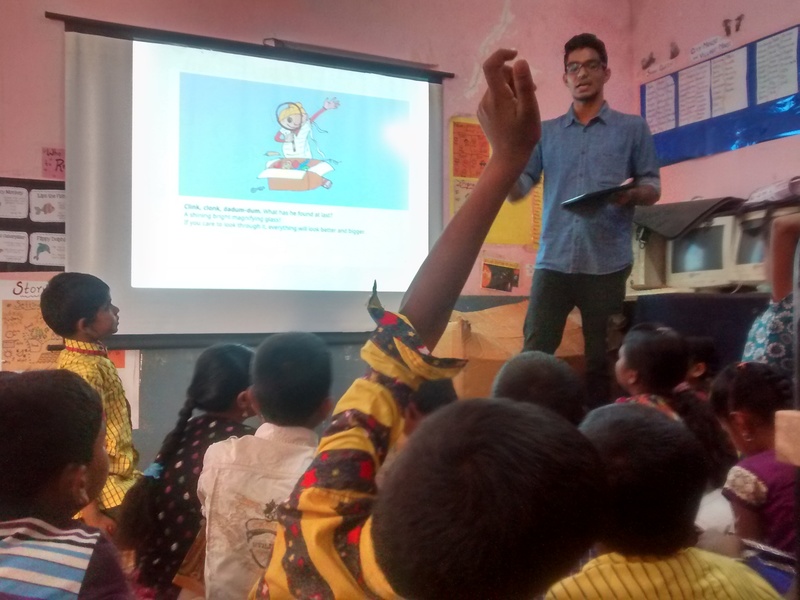
Another lovely moment was when Siddharth asked the children to try and relate aspects of the story to their own lives. He asked them if they knew anyone like Gulli in their homes or neighborhoods who helps without being asked and many children came up with examples of their fathers or friends helping strangers or people in need without an ask for it.
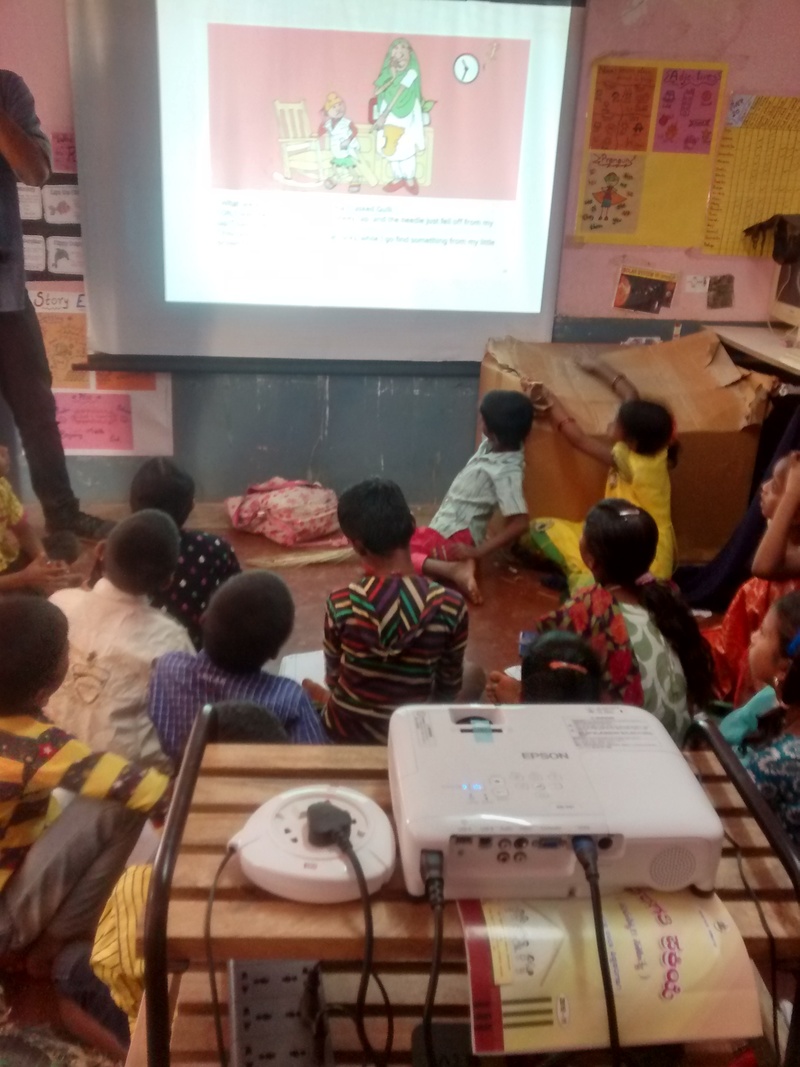
Before we knew the story finished and we were left wanting more, as much as the children did. We wrapped up the visit with a quick interaction with the children and got to know about their favourite books…’Aaloo-Maloo-Kaloo’, ‘Rani’s First Day at School’ and The Giving Tree emerged as clear favorites.
We said goodbye to the little munchkins and promised to see them again!
For the pilot we are currently in the midst of, Teach for India and StoryWeaver are aiming to harness the power of contextual stories and familiar settings to push reading comprehension among children, many of them first generation learners with English as their third or fourth language. The stories are being used for read alouds as well as independent readings with activities created around it to push understanding.
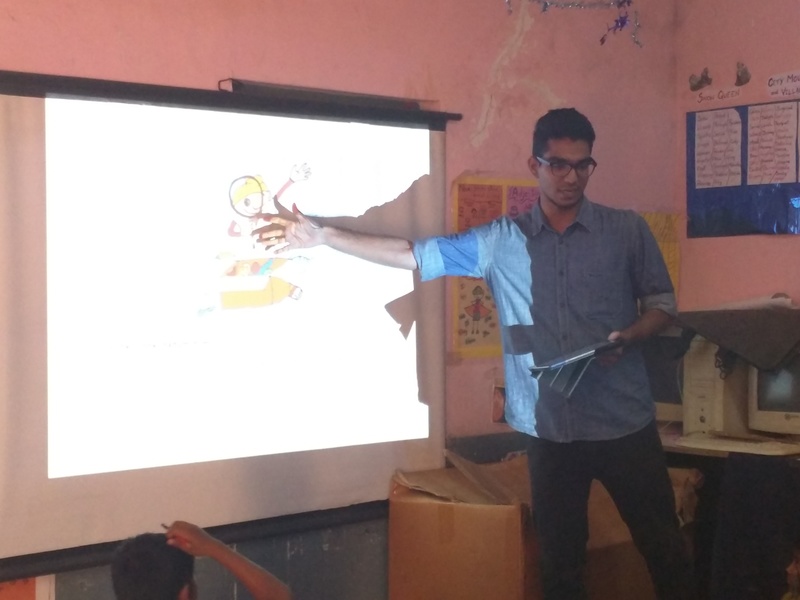
Siddharth Chellappa, whose classroom we visited had this to say -
"StoryWeaver is a great tool to use in the classroom, because it has so many possible applications. I'm able to create differentiated content from a story with such ease for all my children who are at different reading levels. Then, based on student interests I can also create amazing stories using StoryWeaver's collection of illustrations. Most importantly, having access to a massive story library with characters and stories the children can relate to, is the closest thing to a superpower a teacher who loves English and Reading Comprehension can have."
We thank Teach for India for their support and enthusiasm, especially Teach for India Bangalore and Siddharth for letting us into their classrooms.
comment (1)